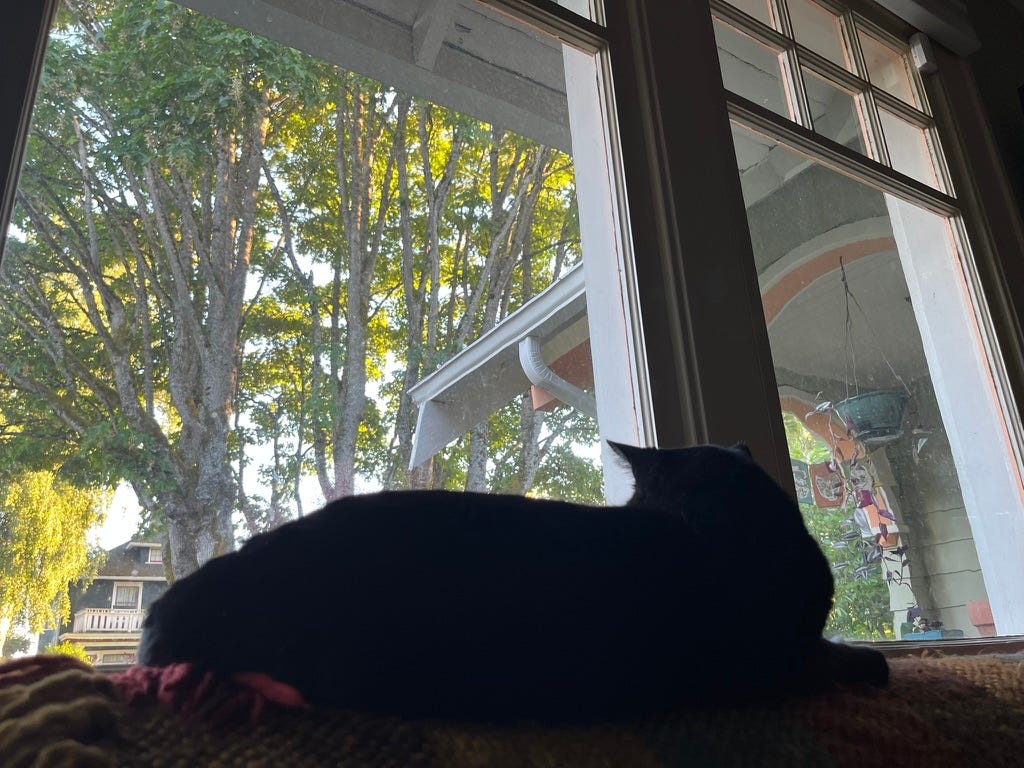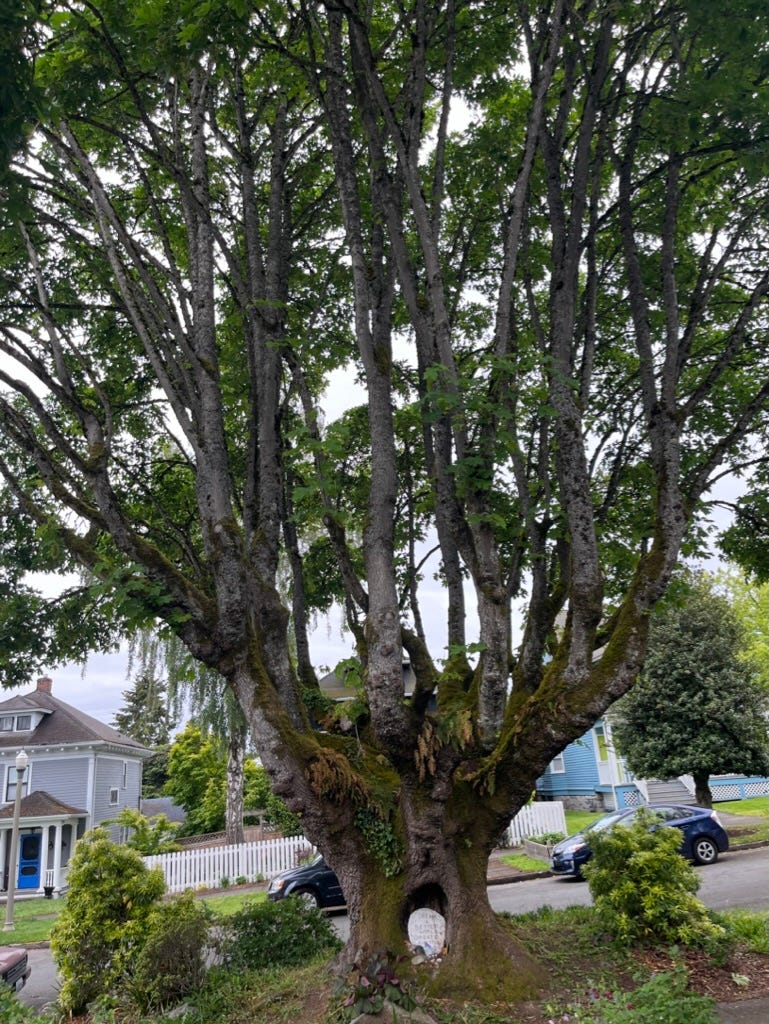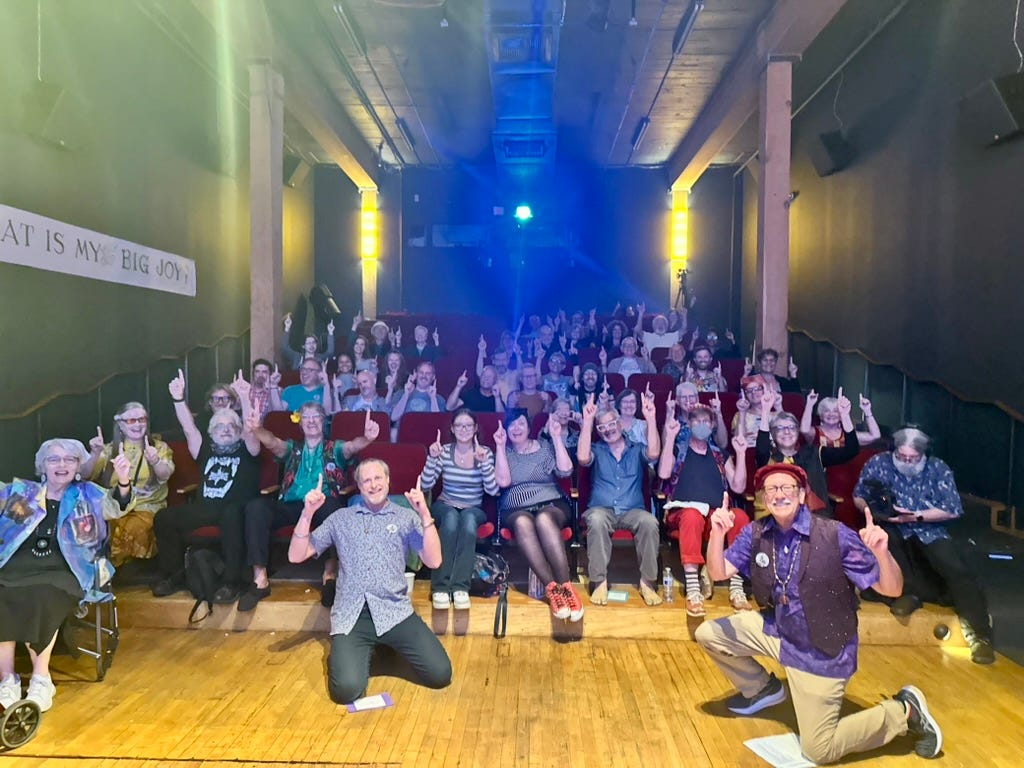How's your nervous system?
How's your ability to rise to this moment in relation to community, human and more than human?
In a persistent effort to concentrate, I’m listening to binaural beats so that I can focus. It is truly soothing sometimes, although not consistently, and it does help me rein in the fear. If fear wins, then fascism has been successful. The latter emotion can be profound if you don’t breathe deeply, spend too much time scrolling through devastating news, and don’t remember that you’re in the present moment. Between the IOF’s assault on the Madleen Freedom Flotilla and the military maneuvering and posturing of the fascist idiots, I recognize that I’m exploding with feelings, a combination of outrage, frustration, and deep sadness. We’re supposed to be doing the work of processing this stuff in community (like our indigenous ancestors did), but I am sitting alone on the couch today, like I have been for many days since I injured my leg.
Unfortunately, I can’t dance my grief and rage out of my body right now because I tore my left calf muscle (tripping and NOT falling - the physics of this injury is a bit mystifying) 10 days ago. Although I can walk gently now, I’m frequently lying on the couch, with ice and compression socks, elevating my legs, as I have off and on many days since I was injured.
As I attempt to write & move intense emotions through me, the images I have been conjuring up are full of rage and violence, not something that is typical for me. I don’t want to share these images publicly and inflict them on our already fragile cells, oversaturated with brutality.
In response to those intrusive thoughts (courtesy of the tendrils of fascism showing up where I don’t want them), I am reminded of Thich Nhat Hanh’s dharma talks about watering wholesome seeds in our store consciousness. Basically, he is suggesting that in order to reduce suffering, let’s look at and do the things that nourish us, whether it is helping others or staying present to the beauty we can access in the present moment. This is not a spiritual bypass or toxic positivity, it is a necessary mindfulness about what any sensitive heart can carry in this time in the world.
Looking up at the grandmother maple tree who told us to move into this house nine years ago, helps quite a bit. For many decades, she has been a powerful entity, housing birds and squirrels, providing shade and play space - she has a wondrous, open, palm-like space covered in moss, ferns, lichen, and ivy, tempting children to climb into her warm nest-like space. She was likely in her toddler years during WWI. Being in her presence, offers me the opportunity to rest my nervous system in deep time. It is a reminder that if I’m going to be of any use to the community, I need to recalibrate in various ways, several times a day.
From my perch on the couch with an elevated and iced leg, I am tended to by our 11-year old, nurse-cat, Aventura (aka Avi) who also enjoys resting her spirit with that of “Grandma May” and below you will find two different angles of this gorgeous being from last summer.
Here you can see the fairy hole that has become an altar of the community’s dreams.
Hopefully gazing at the photos of this magnificent tree has helped those who are reading this post remember that the sacred is available everyday, in the midst of the all the trouble we are witnessing and/or experiencing.
Another nourishing resource for you is this important film, The Eternal Song, produced by the amazing Zaya and Maurizio Benazzo (directors of The Wisdom of Trauma and When Olive Trees Weep) and a team that included folks from Science and Non-Duality. They visited 12 different indigenous communities healing from the trauma caused by white settler colonialism that tried to erase their culture, traditions, and spiritual beliefs. The film creates a fluid montage that weaves together the damage that was done & continues to be done, with the triumph and beauty of communities reclaiming their sovereignty and their sacred relationship to the more than human. What a treat it was to be able to listen on YouTube to dozens of discussions with many activists and a rich array of wise indigenous elders that accompanied the film’s debut week.
So many of the conversations were powerful, but I want to highlight a few that were particularly meaningful to me and the work I’ve been doing on so many levels. One was with Bayo Akomalafe, who I’ve been following for several years. I’m especially grateful for his discussions around neurodivergence (one of my next posts will be an offering about what it means to parent someone who was late “diagnosed”). Directly after that (at the same YouTube link above) is a discussion with Dick Schwartz, the innovative psychologist who created the theories and practice of Internal Family Systems. I had heard about this work for years, but never heard him speak about it and demonstrate it. Just listening to his examples of people who worked with him was profoundly healing and the exiled “parts” of my “self” felt held and refreshed.
Immobility brings many gifts. But, the truth is, I have been semi-mobile. I move slowly from chores in the house, mindfully breathing when I can remember to, and gently pace myself in the garden; when I am not watering, pruning, or weeding, I am harvesting greens and berries for my meals. My sangha joined me in the Zendo last night for our weekly session, and my calf guided our gentle pace during our walking meditation in the garden.
Last Friday, when I was anxiously scrolling through IG, following the journey of the Madleen and the fascist moves of ICE, a dear friend picked me up and drove me to Seattle to see a screening of the wonderful documentary about the life of James Broughton called BIG JOY. Produced by my friend, Stephen, I was thrilled to have some time out of the house in a queer positive crowd, and to remember that the paradox of living in this time. Renewing oneself with loving community is essential medicine, especially when we need each other more than ever in these times.
Stephen (front right) and a team of his artful friends put together a playful frame for this film screening last Friday night at the NW Film Forum.
On Monday night, I slipped out of the house again (after resting most of the day) to perform with my improv team. I started working with this group in early April; it’s been a healing practice to sink into the many principles of improv and just play with a group of open, vulnerable folks. Working with GBYR (Go before you’re ready) has been incredibly therapeutic, although I do yearn for a more socially engaged version of this improv practice. There is no Playback Theater or Theater of the Oppressed groups locally. I did lots of theater and improv in high school and colleage, and Bob and I led Theater of the Oppressed workshops for our students at the Institute for Social Ecology. We worked with Augusto Boal briefly to train for this work as facilitators, as well as the Mandala Center for Change. I’ve signed up to do more work with GBYR in July and we’ll see where this leads me.
After a year of being rejected for every grant that I applied for, I was blown away to be invited (out of the blue) to put together a program for the Seattle Public Library this fall that will help me develop a cohort of people who want to do community-based art interventions to heal, educate, provoke, and provide mutual aid. It will be along the theme of “Art as Medicine for Catastrophic and Transformative Times.” We’re still working out the structure of how this will work and who will be collaborating with me, but I’m super excited about this opportunity (despite the dread of commuting and parking in Seattle). I expect that improv exercises will be part of the mix of tools we bring to the cohort. More about this unfolding project soon.
As a final note, after a brief inner debate and a small dose of nostalgia, I will NOT be attending my 50th reunion for the class of 1975 at Carleton College. I am not a reunion person, although I’ve kept in touch with many dear friends from college (and a couple from high school) for decades.
The reunion organizers asked me to send them three slides of my art and to write a statement that will be shared with my peers. I have pasted it here to share with you.
If it had not been for Carleton, I might not have become an artist. I tried to major in something else; I told my high school art teacher that I was going to study "something serious,” when he asked if I was going to go to art school. I had planned to be an anthropologist or a sociologist or a linguist or a paleontologist, even an organizer (after taking Paul Wellstone’s class freshman year), but the art studio (as well as theater, poetry, & dance) kept pulling at my psyche. Not the teachers, but the energy for dreaming a different world was present in those creative spaces and the community kept me attentive to what was moving through me.
It wasn’t an easy path, not by a long stretch; I had no financial support and it shocked my parents who had planned for me to become a professional of some sort - my mom would say, “why waste a brain like yours.” As a child of poor immigrants, she so wanted me to be upwardly mobile.
But I was lucky, and I arrived in NYC when rents were cheap, got a free ride to grad school with a teaching fellowship, and was accidentally networked well into the contemporary art scene. Those early years brought me recognition that gave me opportunities to exhibit, speak, and teach, and I can thank the late Lauren Soth for inviting me to come back to Carleton to speak and then a year later, to teach as a Dayton-Hudson visiting artist for two years. Without that brass ring, the doors to academia might have been closed to me. Despite my subversive relationship to the status quo, I was able to get tenure twice and raise the social consciousness of students all over the world. Just by sharing their own stories through art and building community in that way, they were able to develop the connections and critical thinking to see how oppressive systems work within them and reimagine the world.
Now in my post-academic years, as I write my fractured memoir, grow food for my community in my backyard, and lead workshops on "art as medicine for catastrophic and transformative times,” I know better than ever, that I made the right choice by going against the family plan. We need art in these times, not as an individualistic endeavor, but as a community practice for healing trauma and visualizing beyond the dystopian nightmares that have been continually unveiling.
The below message arrived this morning from john a powell. So much clarity and insight.
From the Othering and Belonging Institute:
Dear Beverly,
As I watch what's unfolding in Los Angeles and across our nation, I'm reminded of something Gandhi understood deeply: the path we choose in moments of crisis shapes not just our immediate response, but the kind of society we become. Today, we face a manufactured crisis designed to divide us, dehumanize our neighbors, and tear at the constitutional fabric that binds us together.
The story told to the American people in this last election was a fiction—that we needed mass deportations to protect us from a wave of criminality committed by immigrants in our communities. This deliberately pushed a narrative identifying immigrants with crime, and positioned deportation as a public safety measure.
According to this deeply cruel lie, all undocumented immigrants must be rounded up and deported—possibly not to their countries of origin, but simply anywhere outside of the United States.
Whether we agree with deporting people in the country without documentation who have been convicted of crimes, such a policy would never lead to the mass deportation of millions. Targeting people with convictions and meeting arbitrary detention quotas are fundamentally different approaches that were never compatible.
Trump's narrative is a deliberate fabrication designed to manufacture fear, expand federal power, override local authority, and ignore communities where undocumented immigrants are woven into daily life as friends, family, and neighbors.
These are people who have built lives here—colleagues, caregivers, small-business owners—many of whom have contributed to their communities for years, even decades. Now they’re being targeted indiscriminately.
But communities see the truth. As more families from all across the country watch loved ones taken away, the human cost becomes painfully clear. The cruel separation of families and removal of people who sustain our towns and cities exposes the false promise of targeting criminals and the reality of mass deportation that treats all undocumented immigrants as threats.
The administration also claims undocumented residents are straining local law enforcement—another baseless assertion. That lie was exposed when Trump sent in the National Guard, even though the LA police chief publicly stated that protests were mostly peaceful and that no federal support was needed. The unrest in LA was no worse than what we see in many cities after major sporting events—hardly cause for militarized intervention.
The framers of our Constitution were deeply concerned with using military troops against Americans. Soldiers are trained for war against a foreign enemy, not domestic policing. But the White House believes that anyone who opposes Trump—a university, a law firm, a court, a journalist, a protestor— is an enemy and should be attacked and destroyed. We have a name for such a system: Autocracy.
This military deployment is meant to demonstrate power through cruelty, to bully us into submission through spectacle. It also may be unconstitutional and it is certainly immoral, which is why Thursday evening the U.S. court for the Northern District of California found that Trump’s actions were illegal and returned control of the state’s National Guard to the Governor of California, a decision Trump is appealing.
What we do matters
While the courts do their part, we must do ours: call out, resist, and refuse to be complicit as our federal government turns on undocumented residents, people peacefully protesting in our communities, and the Constitution.
I have spoken with many people who say they would have stood up to injustice in Nazi Germany. It’s 2025 in the U.S.—what will we do now?
The Rev. Dr. King offers lessons. He was arrested for challenging not just unlawful acts, but immoral laws. Through nonviolent civil disobedience, like students sitting at whites-only counters, he called on us to reject injustice.
Nonviolence isn't passive—it’s active, disciplined resistance. Civil rights activists trained for it because it takes strength. We may need to do the same and rebuild that muscle of principled resistance.
This means showing up however you can. Write letters. Call your school board. Support community organizations. Paint murals. The key is that we engage, that we all link arms together, and refuse to let fear drive us apart.
We must resist the urge to “other” any group of people, including those in the National Guard or police. While being used for political ends that have nothing to do with their service, leading to some causing great harm, they too have families who are scared for their safety. Let’s meet each other on shared, sacred ground and call them to protect our community, rather than engage on the battleground where there is only violence and mutual dehumanization.
As David French recently wrote in the New York Times, our Constitution accords everyone—not just citizens— the right to be heard by an impartial judge before they are jailed or deported. Due process, at the heart of our Constitution, applies to all people. It reflects the universal concept we hold at OBI that all people belong and deserve the dignity to be heard.
In times of heightened fear, it's even more vital to remember that everyone belongs. We can't return to a democracy for some and not for all.
The most radical act now is to build broad, multiracial political alliances that cross ideological and cultural differences and support pluralism. We do not have to agree on everything to reject othering and cruelty and embrace true democracy.
We're being tested politically, morally and spiritually. The question before us is whether we'll allow ourselves to be divided by manufactured fear, or whether we'll remember that our strength lies in our commitment to each other, to justice, and to the belief that everybody belongs.
In solidarity,
john a. powell
By the way, I’m going to attempt to walk up the 3 stories to my studio tonight so that I can make a fresh sign for the NO KINGS rally tomorrow in Tacoma. I hope that all the readers who are based in the USA will be coming out to feel the solidarity of protest. If you can’t be at a protest, for whatever reason, find another way to create community and feel solidarity - don’t let those fascists make you scared, sitting on the sidelines.







